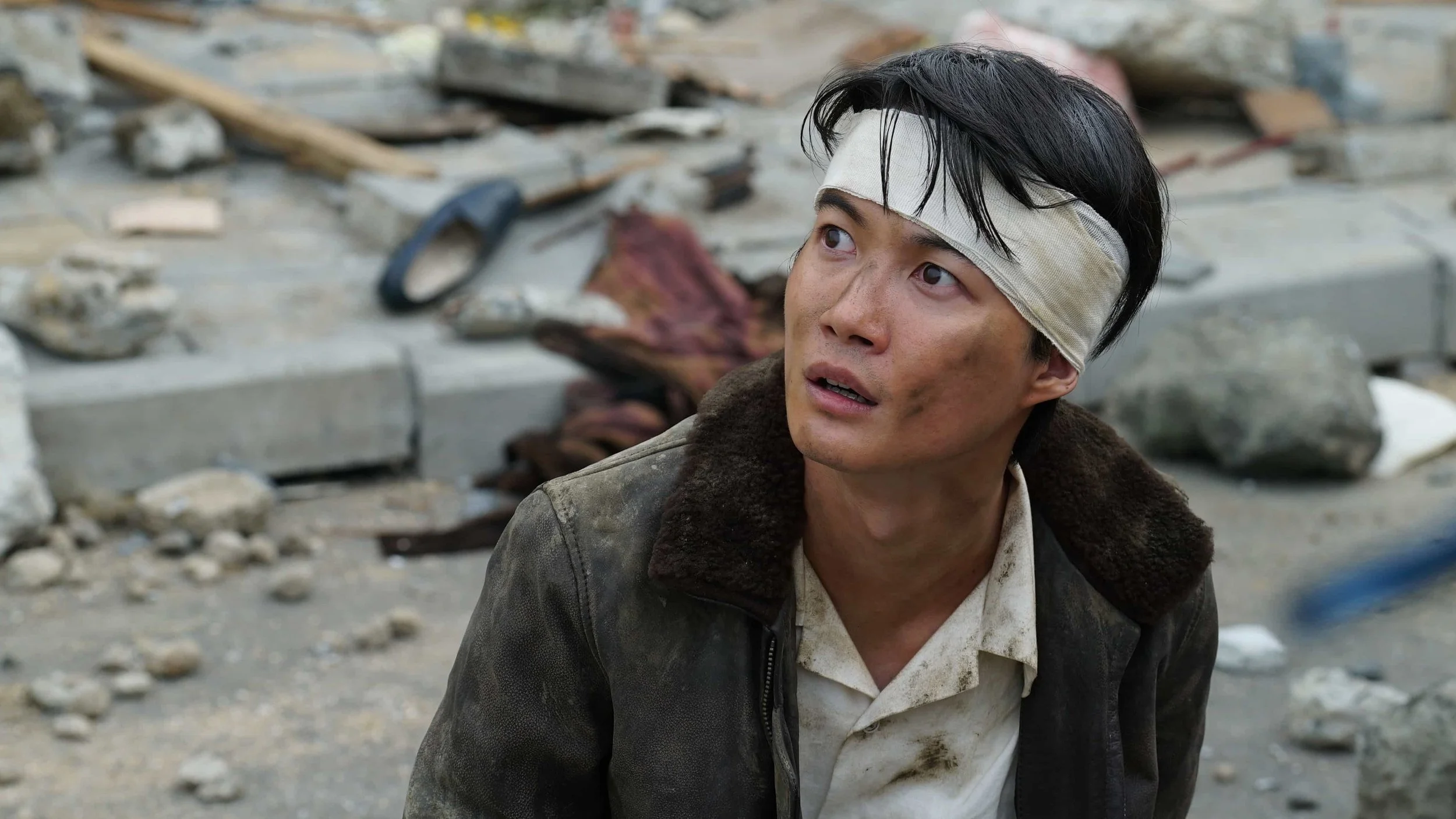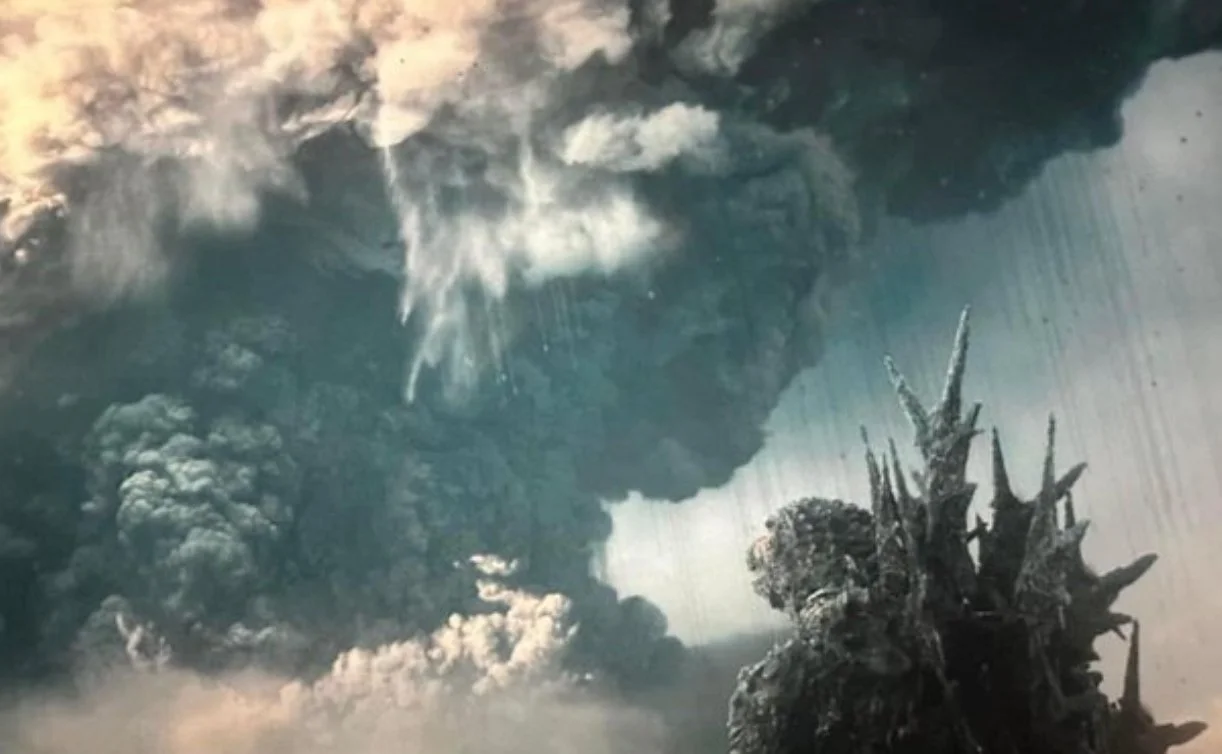A gripping blockbuster, surprising many during its seventy-year run since the original film. It was different from the other movies in the series, made with intense passion. It doesn’t require as much money compared to most big-budget studio films. Most Hollywood blockbusters cost more money and fail at hitting the right marks in terms of endearing characterization, which is essential for a good movie.
By successfully returning to the roots of what made the original film so impactful Takashi Yamazaki created a unique action film, set in a context that makes Godzilla all the more terrifying.
A still of Godzilla, from “Godzilla Minus One”. Toho Co., Ltd.
After the release of the original movie, it succeeded in portraying a monster that symbolized nuclear paranoia in the aftermath of the bombings of Hiroshima and Nagasaki. Since then, the franchise has undergone numerous iterations, some veering into being silly. There are benefits to be found in visual and practical effects, as well as epic kaiju (monster) battles, depending on the audience, no matter how comical.
Each film in the franchise has left a unique mark. Shin Godzilla by Hideaki Anno was a step up at the time for its satirical portrayal of government dysfunction, but it lacked distinct human characters. A common criticism of the many films in the franchise is the need for more well-developed human characters. Often, they are portrayed merely as agents for the audience, serving as plot devices rather than fully realized individuals with genuine emotions and personalities.
Rather than subtly incorporating themes of nuclear paranoia in a contemporary setting, Minus One opts to revisit the Postwar era as its backdrop, focusing on Koichi Shikishima, a kamikaze pilot. He finds himself stranded on Odo Island after abandoning his mission out of cowardice. Godzilla’s sudden appearance on the island results in the devastation of other survivors, leaving Koichi to face yet another harrowing ordeal for survival.
Koichi’s journey is a poignant one, grappling with survivor’s guilt and post-traumatic stress. Upon his return, he is confronted with the sight of homes reduced to ashes, including his own, a constant reminder of his perceived failure by those who view survival as defeat rather than triumph. As life gradually gains momentum, he cares for Noriko and their adopted child. However, Godzilla’s presence weighs on him as he struggles between life and death, bringing him and everyone back to their lowest point, from zero to minus one.
The concept of honor began in the Sengoku Era of Japan before it was called Bushido, a form of duty in the Tokugawa Era. Fulfilling one’s duty has long been ingrained. Those deployed were expected to fulfill their roles in service of the Emperor of Japan. The nation stood as one, at the expense of personal desires. If one answered, others were compelled to follow the same path. To refuse was to risk living in disgrace. “The film critiques the inhumanity,” said Jones and Trefalt, “visited upon soldiers who served within a wartime imperial army and navy paradigm in which honor was predicated on their willingness to die in service to the emperor, and thus the nation.” - Japan Today. “Godzilla Minus One” Offers Insight into Complexity of Japan’s War Memories - Japan Today.” Japantoday.com, 2 Feb. 2024, japantoday.com/category/opinion/%27godzilla-minus-one%27-offers-an-insight-into-complexity-of-japan%E2%80%99s-war-memories.
To tackle themes that resonate deeply with its culture adds a layer that makes it all the more empowering. Any film that addresses the realities of war can experience its grimness. Countless individuals lost their homes, their families, and their sense of hope. Hope was a scarce commodity, as it took many years for Japan to recover from the effects of the war. “Whenever Godzilla appears in the film,” said the director, “he brings a kind of reflection on nuclear war and any manmade crisis. In postwar Japan, citizens were decimated, survivors everywhere were in desperate need of help, and I wanted audiences to gain an understanding of how Japanese survivors felt after WWII.” -Pulliam-Moore, Charles. “The influences of Godzilla Minus One Go beyond the Atom Bomb.” The Verge 4, Dec. 2023, www.theverge.com/23984534/godzilla-minus-one-interview-takashi-yamazaki.
A still of Koichi Shikishima, played by Kamiki Ryunosuke, from “Godzilla Minus One”. Toho Co., Ltd.
Yamazaki masterfully heightens the suspense by crafting scenes reminiscent of early films by Steven Spielberg. A sense of dread occurs as an omniscient tune plays; Koichi’s hand trembles in fear, preventing Koichi from taking the shot at Godzilla. This moment creates an atmosphere where anything seems possible, yet disaster looms regardless of the outcome. As Koichi and the others flee in a minesweeper, Godzilla’s relentless pursuit evokes the shark from Jaws. These early sequences serve as mere appetizers before Godzilla fully asserts his presence. He leaves a trail of destruction in Tokyo, crushing civilians beneath his feet, and reducing buildings to rubble with his tail. His scales bristle one by one before releasing his iconic atomic breath. The film blends classical techniques and effects that believably simulate a high production. While visually stunning, Minus One transcends mere spectacle through its heavy subject matter and nuanced character development. By prioritizing the personal journey of individuals who create their own choices rather than adhering to expected conventions. It elevates itself beyond mere entertainment to a thought-provoking exploration of human resilience.
The characters become singularly focused on defeating Godzilla, having made the decisive choice to confront the monster on their terms. This act symbolizes the country’s collective need to move beyond the war, seeking to alleviate guilt and trauma by confronting their monster head-on.
In contrast with the original, Minus One leans heavily on the importance of preservation rather than destruction. Rather than resorting to a weapon of mass destruction akin to the atomic bomb, such as the Oxygen Destroyer, the characters explore alternative avenues. Defeating a monster would require what created it. Yet, to resort to such a weapon would make them no different from those responsible for the bombings on civilians. Minus One offers a glimmer of hope, suggesting by choosing life over destruction, there exists a possibility of healing after a profound tragedy.
A still of the Visual Effects workflow of “Godzilla Minus One”. Toho., Ltd.
The visual effects were achieved on a modest budget. While most Hollywood blockbusters typically require two to three hundred million dollars, Minus One was produced for under fifteen million dollars. This was accomplished with a small crew in the visual effects department, including Yamazaki himself. Working closely with the team, Yamazaki provided significant creative input while ensuring efficient and timely delivery of the required results. It is very efficient, he said because there’s no gap between what the director is thinking or asking for and the work that is being brought to me. - Grebey, James. “Godzilla Minus One Pulled off Its Oscar-Winning VFX for Less than $15 Million.” Vulture, 10 Mar. 2024, www.vulture.com/article/godzilla-minus-ones-oscar-nominated-vfx-budget-was-usd15-m.html.
The production team made various strategies to stay within budget, such as reusing set pieces and manipulating exterior shots to be captured during post-production. He noted that Japan's Visual Effects departments and production studios are typically smaller than their Hollywood counterparts. While Hollywood relies on third-party sources to supplement their productions, this can significantly inflate the budget. Japanese studios have the advantage of efficiently handling everything in-house, which allows for more streamlined and cost-effective production processes.
A still of Godzilla looking at the mushroom cloud, from “Godzilla Minus One”. Toho., Ltd.
For Visual Effects, Minus One made history by becoming the first film in the franchise to win an Academy Award. It earned acclaim as one of the best movies of 2023.
As is often the case with successful films, there will inevitably be many imitators in the future. Other studios may attempt to replicate Minus One’s techniques but without the same level of authenticity. It’s a familiar pattern in the industry, for both film and television, before another truly unique one emerges. Game of Thrones was hailed as groundbreaking during its run, and numerous shows with high production values sought to emulate its quality. But many fell short of creating their own magical identity.
Yet, despite replicating past successes, it’s important to recognize that success in filmmaking requires more than its technical prowess. With the right team of individuals and a solidly crafted script serving as the foundation, a movie has the potential to resonate with audiences and achieve success on its own merits.



